You can use the scanner glass or the Reverse Automatic Document Feeder (RADF) to load an original for copying, scanning, and sending a fax.
Make sure that no originals are in the RADF. If an original is detected in the RADF, the machine gives it priority over the original on the scanner glass. To get the best scan quality, especially for colored or gray-scaled images, use the scanner glass.
Preparing originals
-
Do not load paper smaller than 25 x 25 mm (1.0 x 1.0 inch) or larger than 297 x 432 mm (11.7 x 17 inches).
-
Make sure any glue, ink, or correction fluid on the paper is completely dry before loading.
-
Open the RADF.
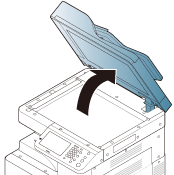
-
Place the original face down on the scanner glass and align it with the registration guide at the top left corner of the glass.
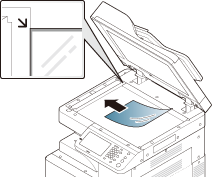
-
Close the RADF.
![[Note]](../../common/icon_note.png)
-
Leaving the RADF open while copying may affect copy quality and toner consumption.
-
Dust on the scanner glass may cause black spots on the printout. Always keep it clean.
-
If you are copying a page from a book or magazine, lift the RADF until its hinges are caught by the stopper and then close the lid. If the book or magazine is thicker than 30 mm (1 inch), start copying with the lid open.
![[Caution]](../../common/icon_caution.png)
-
Be careful not to break the scanner glass. You may get hurt.
-
Do not put hands on the scanner glass while closing the RADF. The RADF may fall on your hands and cause injury.
-
Do not look at the light inside of the scanner while copying or scanning. It is harmful to eyes.
-
Preparing originals
-
Do not load paper smaller than 140 x 140 mm (5.5 x 5.5 inches) or larger than 297 x 432 mm (11.7 x 17 inches).
-
The RADF can automatically detect A5 LEF, Letters or A4 SEF, Legal SEF, A3 SEF.
-
Do not attempt to load the following types of paper, in order to prevent paper jams, low print quality, and machine damage.
-
Carbon paper or carbon-backed paper
-
Coated paper
-
Onion skin or thin paper
-
Wrinkled or creased paper
-
Curled or rolled paper
-
Torn paper
-
-
Remove all staples and paper clips before loading.
-
Make sure any glue, ink, or correction fluid on the paper is completely dry before loading.
-
Do not load originals that include different sizes or weights of paper.
-
Do not load booklets, pamphlets, transparencies, or documents with other unusual characteristics.
Using the RADF, you can load up to 100 sheets of paper (80 g/m2, 20 lb bond) for one job.
-
Flex or fan the edge of the paper stack to separate the pages before loading originals.

-
Load the originals face up into the RADF. Make sure that the bottom of the original stack matches the paper size marked on the document input tray.
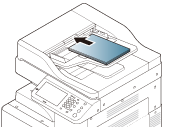
![[Note]](../../common/icon_note.png)
Do not overload the tray: it may cause paper jams. Make sure that the paper is below the maximum paper capacity guide inside the tray.
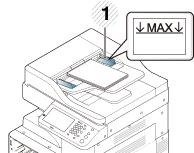
-
Paper capacity guide
-
-
Adjust the document width guides to the paper size.
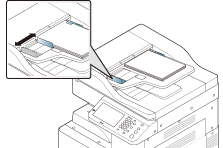
![[Note]](../../common/icon_note.png)
Dust on the RADF glass may cause black lines on the printout. Always keep the glass clean.